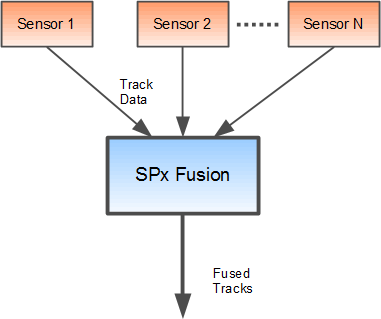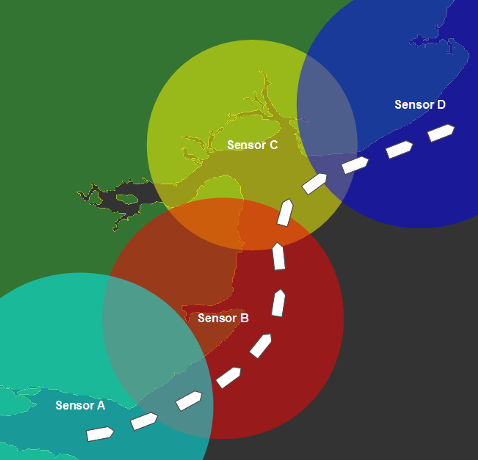
SPx Fusion is a component of the SPx radar processing family and provides the capability to fuse observations from multiple independent sensors into a single stream of correlated reports. SPx Fusion is available as a development library for system integrators to build into their own command and control applications or as an executable application that produces a network stream of fused track data and requires no additional development.
Sensors may be co-located but of different types (e.g. primary and secondary radar) in which case the fusion server generates a single set of output reports without duplicates. Alternatively, sensors may be geographically separated but with overlapping areas, in which case the server provides handover support as targets move from each sensor to the next, preserving a single global target ID across the combined coverage area. A combination of the two modes is also supported.
The sensor data supplied to SPx Fusion may be derived from primary radar video (using SPx Server) or from secondary sources, such as AIS, IFF, or ADS-B.

Track messages generated by processing primary radar video, using Cambridge Pixel's SPx Server application, may be input directly into the SPx Fusion software. Tracks from multiple, separate instances of SPx Server may be input, allowing for fusion of tracks from multiple primary radars.
Equally, SPx Fusion Server will accept a combination of SPx Server tracks and secondary tracks. For example, SPx Fusion Server could be used to combine the primary target tracks extracted from a VTS radar with the AIS messages being received from an AIS base station. Alternatively, the software could combine primary target tracks from an air surveillance radar with the decoded IFF or ADS-B transponder replies from aircraft.
The SPx Fusion software allows the user to assign a "priority" and a "score" to each sensor, which means that the credibility of information from each sensor may be established. Information from sensors which are believed to be more accurate may be given greater credence than other, less accurate sensors.
Where observations for a target are received from multiple overlapping sensors, information from the sensor with the highest priority setting is used in preference to the others.
If multiple sensors share the same priority level, the decision is based on the proximity of the target to each sensor.
Each sensor may be assigned a score value which gives a weight to its observations. The fusion engine only reports fused tracks if the combined score of all sensors supplying observations for the target is ≥1.0.
For example, if the score for each sensor is set to 0.5, then reports will only be output for targets observed by at least two sensors.
For situations where a number of radar sensors provide overlapping coverage it is often desirable for an observer to be presented with a single, consistent set of track labels across the combined coverage area. This is common in Vessel Traffic Systems (VTS) and coastal surveillance applications.
If a target is seen to traverse
from the coverage of one sensor into the next, the track label should not change
as it does so. Nor should the observer be presented with two or more possible
tracks representing the same physical target. SPx Fusion Server can be used in
this situation, with the observer receiving track data from SPx Fusion Server,
rather than directly from the individual track sources.
should the observer be presented with two or more possible
tracks representing the same physical target. SPx Fusion Server can be used in
this situation, with the observer receiving track data from SPx Fusion Server,
rather than directly from the individual track sources.
For situations where two or more sensors are co-located, for example a primary and a secondary radar, SPx Fusion Server can be used to provide a combination of the available information within a single, unified track report.
The track report for a target visible to multiple sensors may contain the most reliable information available from the sensors. Where one sensor provides information that another does not, the track report is a union of the information from both, ensuring that the fullest data is available.
Track reports from the SPx Fusion Server application are distributed as UDP messages over Ethernet. A client SPx class is provided, which allows full run-time control over the SPx Fusion Server and simplifies receipt of the fused target track reports within a custom application.
The SPx Fusion Server is configured at start-up via a simple text configuration file. At run-time SPx Fusion Server is controlled through a network socket command interface. The SPx client interface provides functions to set and get the values of parameters that control the SPx Fusion Server operation.
Using the SPx client interface, track reports are received and automatically decoded into a convenient data structure. Each of the fields that the track message contains (for example track label, position, speed or heading) is readily available within the data structure and may be accessed by the custom application.